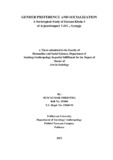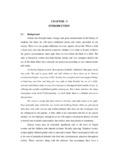Please use this identifier to cite or link to this item:
https://elibrary.tucl.edu.np/handle/123456789/245| Title: | Gender Preference and Socialization A Sociological Study of Daraun Khola-5 of Arjunchoupari V.D.C., Syangja |
| Authors: | Kumar Shrestha, Hum |
| Keywords: | Socialization;Gender Preference;Sociological Study |
| Issue Date: | 2011 |
| Publisher: | Central Department of Sociology |
| Abstract: | Field work of this study entitled "Gender Preference and Socialization" of Arjun Choupari V.D.C.-5 was carried out in ward no. 5 of Arjun Choupari V.D.C. Syangja. This V.D.C. is situated 7 k.m. north east from the Headquarter of Syangja district. There are different caste and ethnic group in the V.D.C. The main prospects and opportunities of this V.D.C. are agriculture (Cash crops) and rural business. The general objective of this study is to investigate the overall situation of gender Preference and Socialization but its specific objectives include. To investigate the role of males and females in the society. To study gender preference regarding socialization. To explore the ways to reduce gender preference. The interview schedules were used for 85 households; 25 Brahmin, 40 Chhetri and 20 Gurung families from ward no. 5 of the V.D.C. by using purposive sampling procedure. Several tools and methods such as observation, focus group discussion with males and females, key informant interviews etc. were conducted to collect the essential information. Mainly quantitative data were collected from interview schedules and qualitative data were collected using focus group discussion and key informant interviews. This study was designed to investigate the role of males and females, son and daughter, husband and wife, girls and boys, marriage and family and other gender related roles and perceptions. The result showed the following findings regarding gender difference in the area. There are all together 229 households with the total population of 1642. Among them male population is 865(52.67%) and female population is 777 (47.33%). The average household size as per the survey is 5.37. There are 247 male household heads and 59 female household heads. The population of the age group 25-45 yrs. was found to be the highest (29.82%) and the population of the age group above 75 yrs. was found to be 1.5%. vii There are 87.58% Hindus, 10.13% Buddhists and 2.29% Muslim and a very negligible percentage of Christians were found to be residing in the area. There are 78 Brahmin family, 121 Chhetri family, 3 Newar family, 9 Magar family, 30 Gurung family in the area. Much of the household work is performed by the females in the area. But in Gurung families, the case was a bit different The socialization process of male and female is found to be different. Females are more responsible for the household problem. The roles, duties and responsibilities assigned to males and females are different. The socialization process of girls and boys is found to be different. Female children are more responsible for household activities than male children. (Sweeping house, cleaning house, cooking food, washing clothes and washing utensils etc). Daughters are given enough time to educate them so that daughter can be capable to live happy life. Almost all the illiterate female respondents were found to prefer son. The educated male and female respondents were found to prefer daughter. In Gurung families, almost all the respondents treated son and daughter equally. Thematic Apperception Test (TAT) analysis in switched gender roles showed that gender role perception is gradually changing in Nepal. Women started doing work which was traditionally done only by men, e.g. Ploughing, repairing roofs etc. It has been found that younger educated men and women might work anything as they wish. Traditional norms and values regarding gender roles were highly prevalent in those respondents who had no education especially females and those engaged in agriculture. Division of labor, role, responsibilities and perception are the determinants of gender difference. viii With the increasing, awareness programs, education, income generating activities, the discrimination between male and female is found to be decreasing. There is less gender difference in younger generation in the comparison of older generation. Too much of work, no access to resources, no decision making power prevalent in older generation have been found to be quite less in the younger generation. According to V.D.C. secretary, the key informant interviewee, there no strict rule in marriage in the Gurung families these days. The marriage between Mama Cheli and Phupu chela and, Mama Chela and Phupu Cheli which was in practice in olden days has now been abolished. According to the V.D.C. secretary, dowry system has started even in Gurung family like in Brahmin and Chhetri. |
| URI: | http://elibrary.tucl.edu.np:8080/jspui/handle/123456789/245 |
| Appears in Collections: | Anthropology |
Files in This Item:
| File | Description | Size | Format | |
|---|---|---|---|---|
| cover (1).pdf | 228.38 kB | Adobe PDF |  View/Open | |
| CHAPTER.pdf | 2.2 MB | Adobe PDF |  View/Open |
Items in DSpace are protected by copyright, with all rights reserved, unless otherwise indicated.
